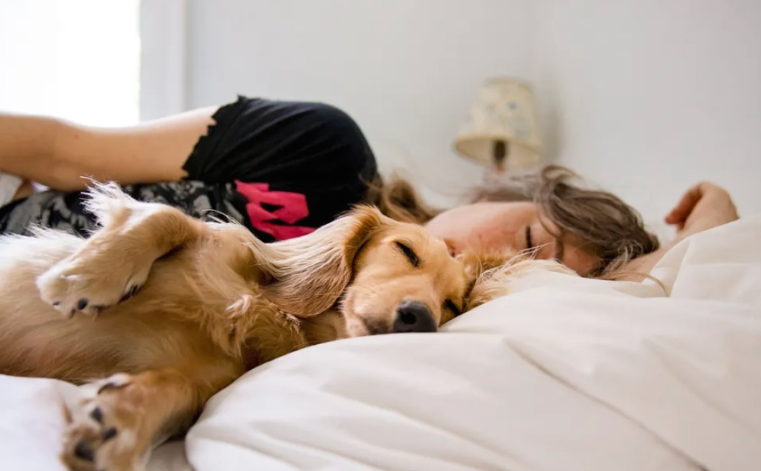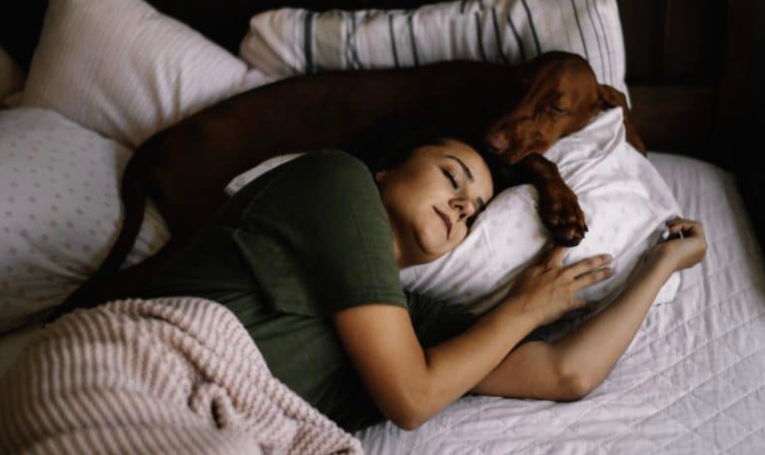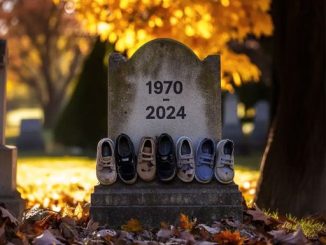
Undoubtedly, the importance of a good night’s sleep for overall health is widely acknowledged. With numerous studies exploring the optimal ways to achieve quality rest, recent research proposes a surprising solution, sharing the bed with dogs. Canisius College in New York State spearheaded this unconventional investigation, revealing that women experience better sleep next to their canine companions compared to human or feline counterparts.
Lead researcher Christy Hoffman, Ph.D., an animal behaviorist, conducted a survey involving nearly a thousand women across the United States to draw these intriguing conclusions. The results unveiled that 55% of participants shared their beds with at least one dog, 31% with a cat, and 57% with a human partner.

Hoffman delved into the reasons behind dogs emerging as superior sleep partners. The study highlighted that dogs’ sleep patterns align more closely with humans than those of cats. Hoffman theorizes that this synchronization may contribute to improved sleep quality, as dogs are adept at accommodating their owners’ sleep schedules, potentially mitigating disruptions caused by differing bedtime routines.
Furthermore, the structured routines imposed by dogs, such as morning walks, assist in regulating their owners’ daily schedules, thereby enhancing overall sleep quality. Another contributing factor is the physical stillness of dogs during sleep, unlike fidgety feline companions. Women in the study reported that dogs tended to remain on the bed throughout the night, fostering a sense of security and stability.
The study’s third crucial finding emphasizes the unique sense of security that dogs provide. Unlike cats or even human partners, dogs offer a heightened level of psychological comfort. Hoffman suggests that the perception of dogs as vigilant protectors, capable of alerting their owners to potential intruders, plays a role in enhancing the sense of security.

Despite these intriguing findings, the study acknowledges the subjectivity of sleep preferences. Factors such as a dog’s snoring or generating excess warmth could pose challenges. Additionally, there are individuals who find solace in the companionship of cats during bedtime.
It’s essential to note that the study relies on participants’ subjective perceptions of their pets’ impact on sleep quality and duration. Consequently, further research is necessary to definitively crown dogs as superior sleeping partners. Hoffman emphasizes the need for continued exploration into the various contexts under which pets positively or negatively influence sleep quality.
As American households increasingly welcome pets, understanding these dynamics becomes crucial. Future research may utilize technologies like Fitbit-like devices to objectively track sleep quality in diverse sleeping conditions, providing a more comprehensive understanding of the intricate relationship between humans and their animal companions during bedtime.
Tori Spelling’s DWTS Journey Cut Short: Here’s What Fans Are Saying
Tori Spelling’s time on “Dancing with the Stars” ended sooner than many fans expected, leaving them feeling disappointed. However, the actress is choosing to see her elimination in a positive light, feeling grateful and empowered by the experience.
This week on “Dancing with the Stars,” it was a big emotional moment as Tori Spelling became the latest celebrity to leave the competition.
The actress and her professional partner, Pasha Pashkov, danced a touching rumba to “This Is Me” from “The Greatest Showman.” Their performance was filled with emotion and showcased their connection on the dance floor.

Their routine received a score of 19 out of 30, bringing their total to 36 over two weeks. Unfortunately, this wasn’t enough to keep Spelling in the competition. Her elimination surprised the audience and left fans with mixed feelings about the outcome.

On the other hand, Chandler Kinney and Brandon Armstrong captivated everyone with their stunning rumba to Billie Eilish’s “What Was I Made For.”
Judge Carrie Ann Inaba was so touched that she cried, praising them by saying, “You created some moments that really touched us all. When dance can reach inside and pull at our heartstrings like that, it’s incredibly powerful.”
Still, Spelling expressed her belief that everything happens for a reason and that her time on the show happened just as it was meant to. Even though her stay was short, she called the experience amazing.
Feeling thankful for the chance to be on the show, Spelling shared how “Dancing with the Stars” changed her for the better. She mentioned that the experience boosted her confidence and helped her believe in herself more.
Tori Spelling’s departure has definitely split opinions among fans, but as the saying goes, the show must go on! The competition is getting tougher, and with more surprising eliminations expected, this season of “Dancing with the Stars” is set to be an exciting journey.



Leave a Reply